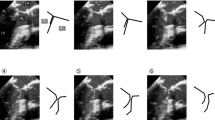Summary
To investigate the mechanism and correlated factors of systolic anterior motion (SAM) phenomenon after aortic valve replacement, 48 patients with severe aortic valvular stenosis were studied. Tested by echo-Doppler one week after aortic valve replacement, the patients were divided into two groups: SAM group and non-SAM group. The data of the left ventricular end-diastolic diameters, the left ventricular end-systolic diameters, the left ventricular outflow diameters, the thickness of the interventricular septum, the posterior wall of left ventricle, the blood velocities of left ventricular outflow and intra-cavitary gradients were recorded and compared. The results showed that no patients died during or after the operation. The blood velocities of left ventricular outflow was increased significantly in 9 patients (>2.5 m/s), and 6 of them developed SAM phenomenon. There was significant difference in all indexes (P<0.05 or P<0.01) except the posterior wall of left ventricle (P>0.05) between two groups. These indicated that the present of SAM phenomenon after aortic valve replacement may be directly related to the increase of blood velocities of left ventricular outflow and intra-cavitary gradients. It is also suggested that smaller left ventricular diastolic diameters, left ventricular systolic diameters, left ventricular outflow diameters and hypertrophy of interventricular septum may be the anatomy basis of SAM phenomenon.
Similar content being viewed by others
References
Sherrid M V, Chaudhry F A, Swistel D G. Obstructive hypertrophic cardiomyopathy: echocardiography, pathophysiology, and the continuing evolution of surgery for obstruction. Ann Thorac Surg, 2003,75(2):620–632
Xu J, Zhao W Z, Shun H T. SAM phenomenon after aortic valve replacement. Chin J Thorac Cardio Vascular Surg (Chinese), 2001,6:335–336
Hatle L, Angelsen B. Doppler ultrasound in cardiology: physical principles and clinical applications. Philadelphia: Lae and Febiger, 1985,202–204
Laurent M, Leborgne O, Clement C et al. Systolic intracavitary gradients following aortic valve replacement: an echo-Doppler study. Eur Heart J, 1991,12:1098–1106
Mingo S, Benedicto A, Jimenez M C et al. Dynamic left ventricular outflow tract obstruction secondary to catecholamine excess in a normal ventricle. Int J Cardiol, 2006,112(3):393–396
Moro E, Ten cate F, Leonard J et al. Genesis of systolic anterior motion of the mitral valve in hypertrophic cardiomyopathy: an anatomical or dynamic event? Eur Heart J, 1987,8:1312–1321
Chen H Z. Heart Diseases. 5th ed. Beijing: People’s Public Health Press, 2000,1279–1290.
Auer J, Berent R, Weber T et al. Catecholamine therapy inducing dynamic left ventricular outflow tract obstruction. Int J Cardiol, 2005,101(2):325–328
Yalçin F, Muderrisoglu H, Korkmaz M E et al. The effect of dobutamine stress on left ventricular outflow tract gradients in hypertensive patients with basal septal hypertrophy. Angiology, 2004,55(3):295–301
Author information
Authors and Affiliations
Additional information
XU Jing, male, born in 1964, Professor, M.D., Ph.D.
Rights and permissions
About this article
Cite this article
Xu, J., Wen, J., Shu, L. et al. Mechanism and correlated factors of SAM phenomenon after aortic valve replacement. J. Huazhong Univ. Sc. Technol. 27, 72–74 (2007). https://doi.org/10.1007/s11596-007-0121-2
Received:
Issue Date:
DOI: https://doi.org/10.1007/s11596-007-0121-2




